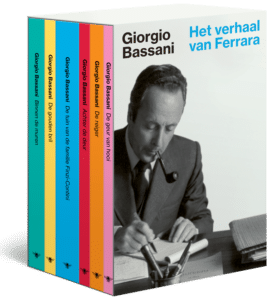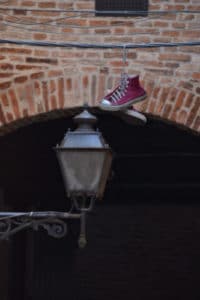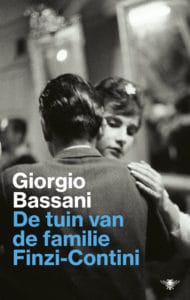A flat and desolate landscape stretches on either side of the old road to Ferrara. Agricultural areas, created on the fertile soils of the Po delta, leave an impression of decay. Gradually, they flow into suburbs with a predominantly industrial character. Little indicates the approach of the Italian city designated a UNESCO World Heritage Site.

Castello Estense
Once inside the old city walls, Ferrara gradually reveals its memories. The contrast between the modern shopfronts and the beautiful, centuries-old buildings that house them emphasises an atmosphere of transience and the passing of time. Rattling over the cobblestones, residents of Ferrara hurry home on their bicycles. Only a single passer-by pays attention to the violinist playing his false notes under the arcades opposite the medieval city castle Castello Estense.
Painfully topical
Ferrara sets the scene for all novels and stories by the Italian-Jewish writer Giorgio Bassani (1916-2000). The reissue of his work by De Bezige Bij brings the author's penetrating prose back into the spotlight. Even today, Bassani's work is painfully topical. His stories are about the (unwanted) confrontation with reality; about truth, lies and betrayal.
But above all, they are about excluding or ignoring individuals, population groups and events that are unwelcome. Bassani experienced this first hand when racial laws were proclaimed in 1938 and Jews were no longer welcome anywhere. Almost all his characters become victims of exclusion: for instance, because they are Jewish, homosexual or unmarried and pregnant. In the streets of Ferrara, Bassani echoes the cutting judgment of the masses, which is changeable and treacherous like the weather: 'You should lock them up in the ghetto again, all those Jews: ridiculous to feel sorry for them!'
Jewish ghetto
The story of Ferrara lets the reader wander through the streets, the alleys, the dark and oppressive Jewish ghetto. Over the city walls and the Catholic and Jewish cemetery. The café opposite the Castello Estense calls to mind Bassani's Caffè della Borsa: the café where friend and foe alike would descend for coffee or drinks and comment on townsfolk, rumours and everyday events.
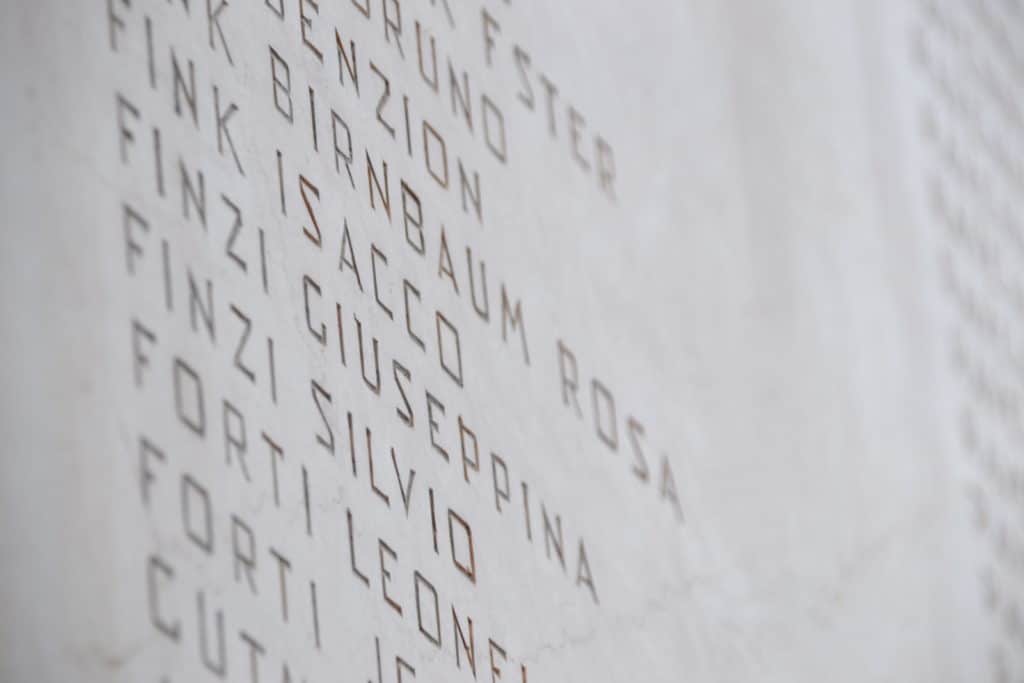
In that former ghetto, only a few streets big, the atmosphere even today is different from the rest of the city centre. It is darker and quiet. This is where 'A plaque in via Mazzini' is set, one of Bassani's finest short stories, and one of horror. Jewish Geo Josz returns from the German concentration camp Buchenwald in August 1945. Just then, at the synagogue in via Mazzini, a plaque is affixed to the wall with the names of Jewish victims. His name is included. He also no longer has a home - his villa on via Campofranco has been taken by the partisans. No one expected his return and no one knows what to make of it.
Weird fur hat
Josz looks bloated and strange in his camp clothes and that weird fur hat of his. Soon tongues are hissing that hunger must not have been so bad, otherwise he wouldn't be so fat - no one had heard of hunger oedema. Or perhaps Josz had managed to arrange preferential treatment for himself, the malcontents wonder. 'Please, what else did he have to complain about, he had to stop his whining.'
While Josz is increasingly desperate to be seen and heard, citizens and former fascists want above all to forget what happened. They prefer not to be confronted with their not too clear conscience anymore. One therefore breathes a sigh of relief when the now scrawny Josz - close to madness - disappears into thin air overnight.
A night in '43
Pharmacist Pino Barilari in 'A Night in '43' also chooses to close his eyes. He witnesses how at night, right in front of his pharmacy on Corso Roma, 11 Ferraris are shot. But he also sees something else: his wife, returning from an extramarital escapade, walking along the pile of bodies. Their gazes meet, but when she enters, Barilari pretends to be asleep. At a trial of the perpetrators, he claims he saw nothing. To admit that he did watch the massacre is to acknowledge his wife's adultery, and that is too much to face. But from then on he sits - out of guilt? - with binoculars at the window to call to order passers-by who walk too close to the memorial plaques for the fallen.
Human dignity
In the characterisation of his characters, Bassani spares no one - Jewish or not. Only a few make a difference, like the family in his most famous novel The garden of the Finzi-Contini family (1962). When Jews, including the first-person narrator Giorgio, are excluded from the local tennis club, the wealthy Finzi-Continis open up the tennis court on their estate. They choose to live out of the moment, so to speak, untouchable for what lies ahead.
Micól, the daughter with whom Giorgio falls in love, is distinguished from other Bassani novel characters by her highly expressive, idiosyncratic attitude to life. Unlike many other Jews, who were initially ardent supporters of fascism, joining 'just to be sure' or watching indecisively, Micól's father is unequivocal in his rejection of it. Despite being aware of impending deportation, the Finzi-Continis manage to maintain their authenticity, truthfulness and human dignity in the seclusion of their own world - the ultimate victory over fascism.

Unwanted mirror
Bassani's stories are a mirror for human behaviour that not everyone likes - and wanted - to look into. It did not make the writer unpopular in Ferrara, even within the Jewish community. When Henk Pröpper, author of the wonderful booklet Giorgio Bassani's Ferrara, a universe, visited Ferrara in the 1990s, there was little that recalled his beloved author. No plaques for Bassani on his house or school, no prominent place in bookstores.
How different it is today. In the large bookshop near the cathedral, Giorgio Bassani's novels stand proudly on a shelf by the counter amid other Ferrarese authors. Vittorio De Sica's Oscar-winning film adaptation of The garden of the Finzi-Contini family is on the shelf in multiples. The house inhabited by the protagonist in that film turns out to be the home of Bassani himself, located in via Cisterna del Follo. A plaque has adorned the facade since 2009, and a plaque now also hangs on the building where the writer went to school.
Perhaps time has healed the wounds and the conscience of the generation that was itself part of the stories is less addressed. The prison on via Piangipane, from which Jews were deported at the time, is now the National Museum of Italian Jewry and the Shoah. In doing so, it reveals a history that had long been shrouded in shameful silence.
Fact and fiction
Not everything in Bassani's stories corresponds one-to-one with reality, but many places and characters are indeed created after reality. Geo Josz's house with the swallowtail battlements does exist, albeit not in via Campofranco but in via Cisterna del Follo: Bassani lived next door. And anyone trying to find Josz on the plaque at the synagogue should look for the name Eugenio Ravenna, on whose account the story was based.

The tomb of the Finzi-Magrinis
Whether the Finzi-Continis had a model in reality has long been a closely guarded secret. In the Jewish cemetery, the Finzi-Contini family's mausoleum from the novel cannot be found. The old lady who opens the cemetery's iron gate turns out to be a Bassani herself. She does know the score, she murmurs softly. 'He derived the name Finzi-Contini from the Finzi-Magrini family. It's not at all a gaudy grave like the one in his book, it's sprung from his imagination.'
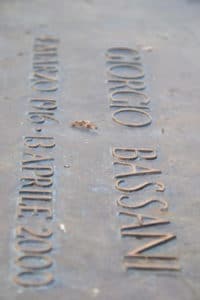
She tells where to find Bassani's grave. After his death, the writer returned to Ferrara. His grave is one of the few recent ones in the dilapidated cemetery.
Nearby, we also find the tomb of the Finzi-Magrini family. Silvio and Albertina Finzi-Magrini were deported to Auschwitz in 1944. Next door lies their premature baby Gabriele (Guido in the novel) and Umberto (Alberto). Their son died of an illness in 1942 at the age of 30, even before they could deport him. 'And look,' the woman points out, 'there lies Micól. In reality, her name was Giuliana. Her husband Marcello Pesaro is buried next to her.'
In the novel's prologue, first-person narrator Giorgio says that only one person had been laid to rest in the monumental tomb: Alberto. Of Micól, her father Ermanno and mother Olga, it had always remained unclear whether they had ever found a final resting place. But presumably Bassani knew better: his beloved 'Micól' was buried just a few paces away from him.
Truth
The palpable veracity of the figures and events gives Bassani's work great power. The story of Ferrara tells of a past that is not a past and speaks of a silence that cannot be hushed up. The truth it illuminates constitutes a timeless invitation to make a positive contribution to human dignity as an individual. It is precisely this that makes Giorgio Bassani's voice and the publication of his work urgent and valuable even now.
The story of Ferrara includes the books Inside the walls, The golden glasses, The garden of the Finzi-Contini family, Behind the door, The heron and The smell of hay.
Translation Jan van der Haar, except The smell of hay: translation Tineke van Dijk.
De Bezige Bij, €15 each. (12.50 via the links above)
